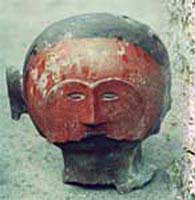|

|
|
Maitum
anthropomorphic jars.
Photo courtesy of the National Museum |
MAITUM, Sarangani -- This town plays a very
important role in determining the prehistory not only of Mindanao
and the Philippines but also of Southeast Asia.
But while the archaeological find here is now known worldwide,
majority of the residents here are not aware of this.
In fact, for most teachers and other town officials here, the
forum last Thursday with archaeologist Dr. Eusebio Dizon of the
National Museum was the first time they learned of the
archaeological find here 11 years ago of anthropomorphic potteries
dating back to the Metal Age, a find that Dizon describes as
"unparalleled in Southeast Asia."
Dizon, Curator I of the Archaeology Division and Head of the
Underwater Archaeology Section of the National Museum and Director
of the Archaeological Studies Program (ASP) of the University of
the Philippines, headed the team 11 years that did the
archaeological study of the now famous anthropomorphic secondary
burial jars in Pinol Cave, also in Maitum town.
At the end of the forum, the teachers said the Department of
Education (DepEd) should include the Maitum Jars in the history
textbooks because "our students are familiar with the Tabon Cave
in Palawan but not Pinol cave here."
This town has 20 elementary schools, four secondary schools and
one college.
Adelina Raganit, principal of the Malalag Central Elementary
School here told MindaNews after the forum that their students do
not know about the Maitum Jars because these are not found in
textbooks. "Mas alam pa nila ang Tabon Cave. Sana ilagay naman sa
textbook" (They know more about the Tabon Cave. We hope Pinol cave
will be included in the textbooks, too).
Dizon spoke at the forum after doing a preliminary study in a
cave in Sitio Linao, Barangay Kiambing, which yielded potsherds
from various periods, including those that are likely to be 3000
years old.
 |
|
|
Jun Ramos,
Sarangani Fotos |
Few of the predominantly Ilocano-Cebuano-Manobo populace in
this town (estimated population: 35,536) understand the
significance of the yield in Pinol Cave (formerly known as Ayub
Cave), which Dizon refers to as "the most significant cave in
Mindanao."
Mayor George Yabes scheduled the forum with Dizon to ensure
residents understand the significance of the Maitum find.
The archaeological find at Pinol Cave consists of
anthropomorphic burial jars that date back to the Metal Age or
nearly 2000 years ago.
The anthropomorphic potteries were designed and formed like
human figures with complete facial expressions and used as covers
for secondary burial jars. Also found were glass beads and
bracelets; shell spoon, scoop, bracelets and pendants; earthenware
potteries with incised designs and cut-out foot-rings; and
non-anthropomorphic burial jars.
While anthropomorphic pottery had been found in Bacong, Negros
in Western Visayas; Huyop-huyopan, Albay in southern Luzon;
Palawan and in Kulaman Plateau in Southern Mindanao, the faces
depicted in the pottery of Maitum are unique in that, according to
authors Dizon and Rey Santiago in the book "Faces from Maitum: The
Archaeological Excavation of Ayub Cave," they "are like portraits
of distinct individuals or specific dead persons whose remains
they guard."
"Some faces are thin with pointed chins and shriveled puckered
mouths associated with the toothless or the aged. Other heads wear
a smile displaying a full set of teeth. A patch of black paint on
the head indicates where hair should be. Others with perforations
suggest a more realistic portrayal. Had hemp fiber filled those
holes to represent tufts of hair? Who were these people? When, and
how did they live?" the authors asked.
Who, indeed, were these people depicted in the anthropomorphic
potteries in Maitum? When, and how did they live?
The questions cannot be answered as yet, given the constraints
faced by the National Museum team, among them, security, funding,
time constraints, absence of laboratory analysis, and the fact
that before Dizon's team came, the cave had been "severely
disturbed" because a Japanese national financed a digging there in
search of gold bars.
At best, the authors said, they can only offer preliminary
analysis.
Last year, Dizon told MindaNews he tried to get funds for the
Accelerated Mass Spectroscopy (ASM) "which is better and more
accurate than the conventional C-14 dating technique for the
archaeologically excavated artifacts from this Ayub cave."
Dizon and Santiago wrote that the discovery of the burial jars
"is very important in our study of Philippine prehistory. It can
provide significant clues and material evidences for the
determination of the Maguindanao prehistory."
But both said the research "must not end here. Other links must
be found and forged in order to piece together our past."
A link could have been found within Maitum itself, in the cave
in Sitio Linao which Dizon and his team visited on Wednesday and
Thursday last week but the cave has been "heavily disturbed" by
treasure diggers.